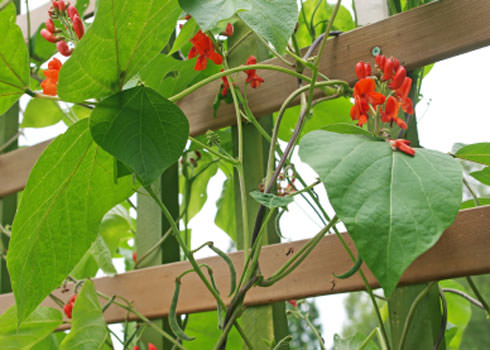

Try growing beans vertical by guiding them up a trellis.
If you’ve ever longed for a lush garden full of vegetables but have put that dream aside because you live on a 1/4-acre lot or in a high-rise condo, you might be surprised to know that your high hopes really can blossom. Vertical-gardening techniques can put fresh tomatoes, cucumbers, spinach and more within easy reach—literally.
 Vertical gardening uses an assortment of support structures to help plants grow up instead of out, where their sprawl can take up a lot of space and leave fruits and vegetables vulnerable to diseases, scarring and garden pests. A garden filled with vertically grown vegetables not only produces more in a small space but can also camouflage unattractive structures, provide privacy and shade, and add interest to landscaping. Vertical structures also make a garden more manageable for those who have difficulty bending and stooping, because the vegetables are at eye-level and above, making them easy to prune and check for garden pests.
Vertical gardening uses an assortment of support structures to help plants grow up instead of out, where their sprawl can take up a lot of space and leave fruits and vegetables vulnerable to diseases, scarring and garden pests. A garden filled with vertically grown vegetables not only produces more in a small space but can also camouflage unattractive structures, provide privacy and shade, and add interest to landscaping. Vertical structures also make a garden more manageable for those who have difficulty bending and stooping, because the vegetables are at eye-level and above, making them easy to prune and check for garden pests.
Starting a vertical garden isn’t hard. Many garden-supply centers offer ready-made supports, including stackable containers and an assortment of trellises, tepees and netting. The most common structures are those designed to support tomatoes, such as the tomato cage and the hanging “upside-down” tomato planters.
There are a surprising number of items that can easily be put to work as garden supports: fences, old gutters, saplings, branches, other plants and even your apartment staircase. For small spaces, vertical gardens often work best in combination with containers or raised beds.
The plants that thrive in a vertical garden are those that are naturally vining, sending out tendrils to grasp their way along as they grow, including cucumbers, winter squash, pumpkins, melons and grapes. But tall, non-vining plants, such as tomatoes, work equally well in a vertical system, given the proper support. And believe it or not, you can even grow low-growing plants vertically.
One key to any successful garden is sunlight. Vertical structures will help expose plants to more of the sunlight available in your area. In situating your vertical garden, be careful your vertical structures won’t cast shadows that could keep sunlight from lower-growing plants. Most vegetable plants need an average of 6 hours of sunlight daily, though root vegetables and some cool-weather-loving plants will tolerate some shade. In a vertical system, sun-loving plants should be grown in a north-south orientation, ensuring that one side will get morning sun from the East and the other will get afternoon sun from the West.
Propping Vertically Grown Plants
Joe D’Eramo, a gardener in Harvard, Mass., who began practicing vertical gardening 16 years into his gardening career, was inspired by Mel Bartholomew’s book, All New Square Foot Gardening: Grow More in Less Space! (Cool Springs Press, February 2006). After reading Bartholomew’s book, he created a garden of raised beds and upright structures that can only be described as an engineering marvel. He says that the source for all the vertical framing was the “take-it-or-leave-it” section at the local transfer station.
His 7-foot vertical structures, aligned along a north-south axis, are made of discarded metal tubing, and he uses plastic trellis netting with a 6- by 51⁄2-inch mesh to support the plants. The garden is completely enclosed in deer fencing, and weeds are kept at bay with Lumite landscape fabric, which helps give the garden the feel of an outdoor room. He uses the vertical system to grow tomatoes, cucumbers, pole beans and butternut squash.
If you’ve never gardened before, it can be tempting to rely on ready-made structures available at your local garden center. Depending on how much you hope to grow, that can get expensive. There are many structures you can make yourself (such as a portable trellis), from the simple to the sublime, using readily available materials—maybe even those lurking in your own backyard.
If you’re partial to a natural look, suitable branches leaned against a wall or tied together tepee-style make an attractive structure for peas, beans or cucumbers. You can actually use tall, erect plants to serve as climbing posts for vining plants. A traditional practice among Native Americans has been to plant the Three Sisters together—corn, beans and squash. The sturdy, upright corn acts as a support for the climbing beans, which in turn add nitrogen to the soil for the heavy-feeding corn. The squash is allowed to crawl along the ground, crowding out the weeds that would otherwise hamper the growth of the beans and the corn. Like corn, sunflowers can also be used as a support plant.
Page 1 | 2




